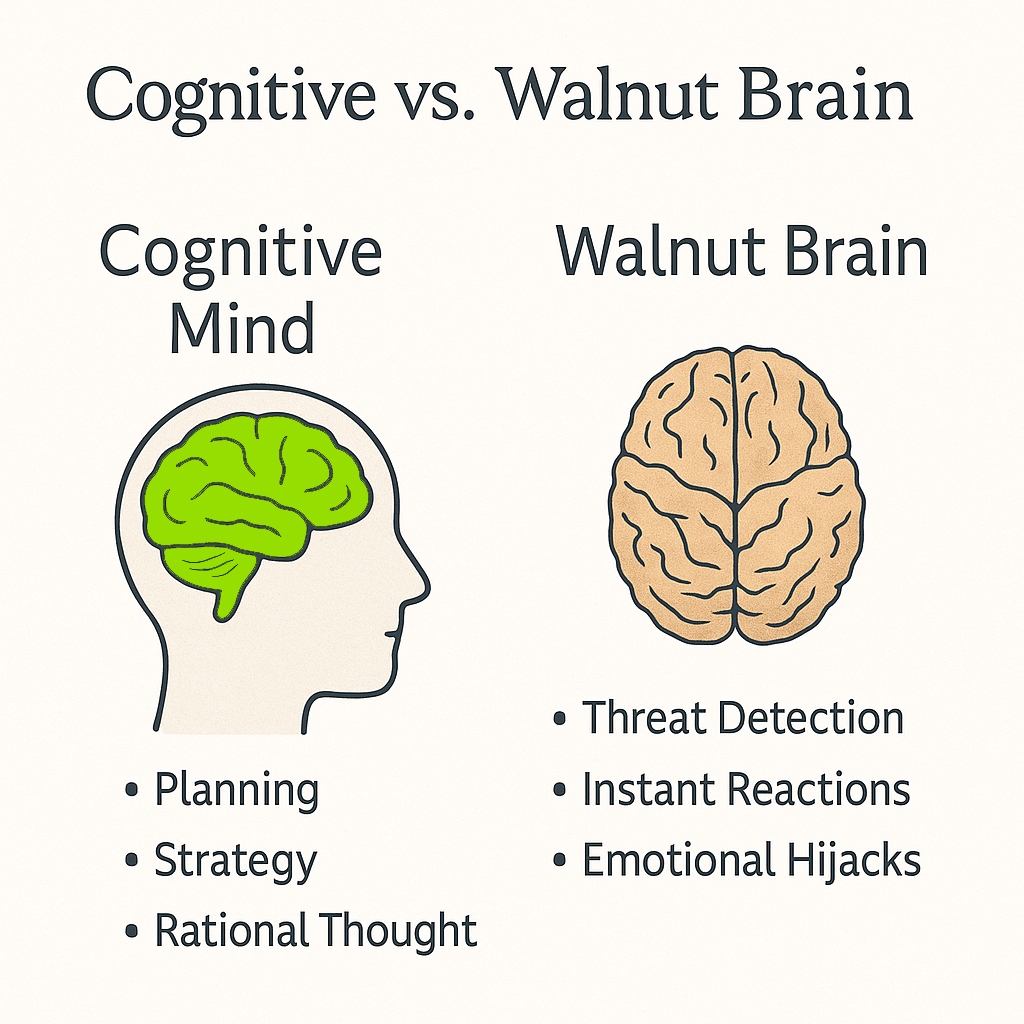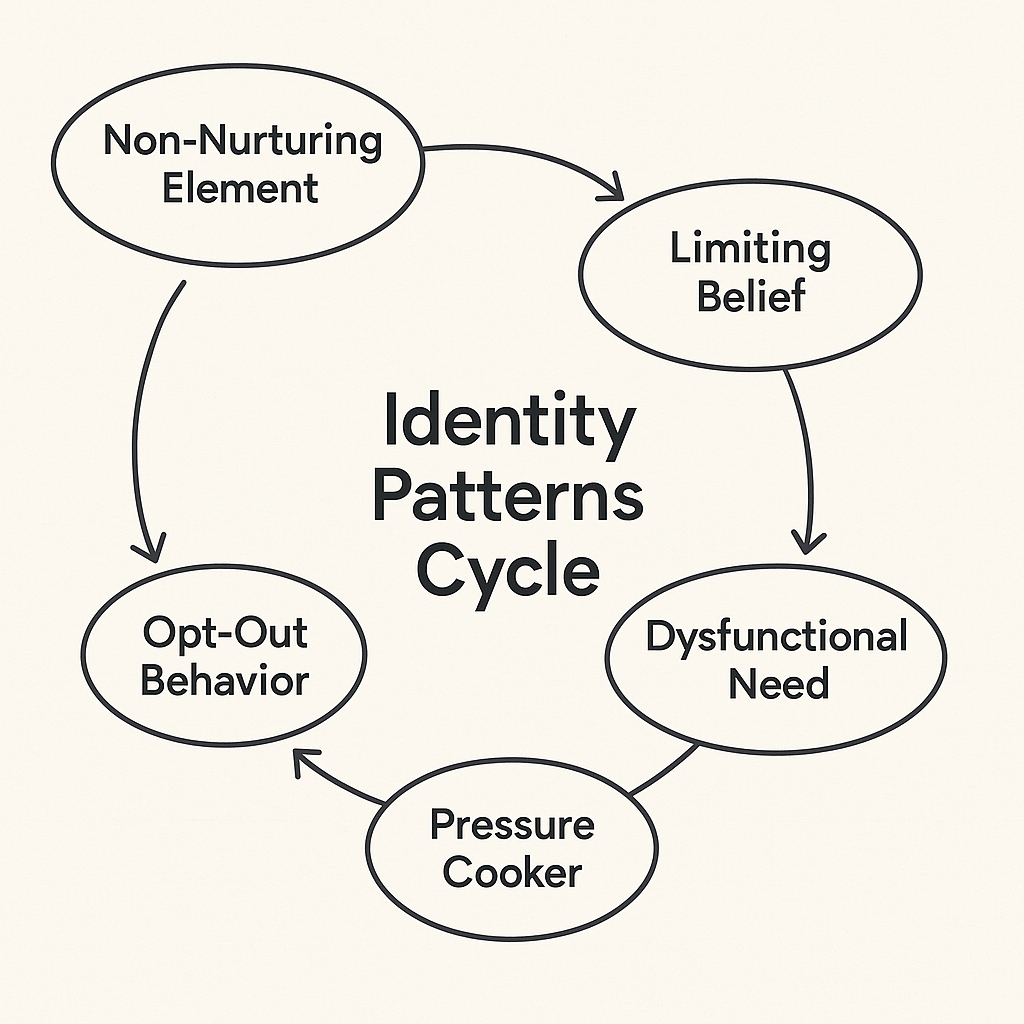Introduction:
When Willpower Won’t Cut It
You’ve felt it:
You know what needs to change. You get why you react the way you do. But the moment hits, and once again, you find yourself slipping back into old habits.
This isn’t about lacking willpower.
It’s not a logic problem.
It’s your Walnut Brain—your survival system—pulling you back into protective patterns faster than your rational mind can even catch up.
At ShiftGrit, we don’t just scratch the surface.
We go straight for the identity patterns: the deep, automatic loops in your emotions and thoughts that control how you think, feel, and act—even when you know better.
This is the Identity Pattern Therapy experience.
This is where change doesn’t just happen—it sticks.
What Are Identity Patterns?
Identity patterns are the automatic loops that drive your emotions and behaviours—without you even realizing it.
They’re formed from non-nurturing elements™—things like inconsistency, criticism, or trauma—that teach your brain certain beliefs are essential for survival. Over time, these beliefs crystallize into the core messages that quietly shape your identity:
“I am not good enough.”
“I am a burden.”
“I am invisible.”
“I am unworthy.”
These identity-level beliefs run in the background, influencing how you think, feel, and act—even when you consciously know better.
These limiting beliefs don’t just sit in your mind—they control your emotional responses, your survival instincts, and your actions, all without your conscious awareness.
But here’s the kicker:
These aren’t random habits.
They’re survival systems your brain learned to keep you safe, and over time, they’ve embedded themselves deep into your identity.
And unless you address them, they’ll continue running the show.
How the Walnut Brain Traps Patterns
Your Walnut Brain—our shorthand for your fast-acting emotional survival system—is designed to prioritize safety before reflection.
When it detects a threat—real or imagined—it jumps into protective mode, triggering automatic responses before your rational, Cognitive Brain even gets a chance to think.
This is why you find yourself overreacting, shutting down, self-sabotaging, or people-pleasing—often before you even realize it’s happening.
Your Walnut Brain isn’t “wrong.”
It’s just running on outdated threat filters, built from your earliest experiences, that keep you stuck in the same old patterns.


Why Insight Alone Isn’t Enough
You might understand that your reaction is irrational.
You might know that your boss isn’t your critical parent.
You might realize that not every mistake means rejection.
But your Cognitive Brain — where insight lives — is slower than your Walnut Brain.
And once the threat system is triggered, it hijacks emotional and behavioural control.
This is why lasting change requires more than talking.
It requires recalibrating the internal system that misreads threats in the first place.
The Identity Pattern Loop
Every identity pattern follows a predictable cycle:
| Stage | Description |
|---|---|
| Limiting Belief | “I’m not safe,” “I’m not worthy” |
| Dysfunctional Need™ | “Be perfect,” “Control everyone” |
| Emotional Suppression | Hiding feelings to meet need |
| Pressure Cooker | Internal emotional strain builds |
| Opt-Out Behaviour | Shutdown, overcontrol, lashing out |
Each time this loop repeats, the Walnut Brain reinforces its perception that the original limiting belief is true.
Until you break the loop at the emotional level, it continues — even if you cognitively “know better.”


How ShiftGrit Breaks the Loop: Identity Pattern Therapy
At ShiftGrit, we don’t just talk about your patterns.
We retrain the emotional systems keeping them alive.
With our Reconditioning Protocol, we take you step-by-step to break the loop:
- Pattern Identification: Name the loops holding you back.
- Emotional Activation: Trigger the pattern to get to the root.
- Perceptual Reframing: Show your Walnut Brain the threat isn’t real.
- Counter-Conditioning: Replace old reactions with calm, reality-based responses.
- Reinforcement: Lock in new reactions with real-life practice.
This isn’t therapy as usual.
It’s a shift that sticks.
Why This Creates True, Lasting Change
When the Walnut Brain stops misinterpreting emotional experiences as threats:
- The Cognitive Brain regains leadership
- Emotional reactions become proportionate
- Old patterns dissolve
- New behaviours become automatic, not forced
This isn’t coping.
This is repatterning your identity system at its roots.
FAQ
You’re not alone if you have questions. Here’s what people often ask when they first discover Identity Pattern Therapy—and what you can expect when you work with us.
What is Identity Pattern Therapy?
How is Identity Pattern Therapy different from traditional talk therapy?
What kinds of problems can Identity Pattern Therapy help with?
What is a “limiting belief” and why does it matter?
What can I expect during Identity Pattern Therapy sessions?
How long does Identity Pattern Therapy take?
Ready to Break Your Patterns?
Take the next step toward real identity-level change.
Contact our team to explore whether Identity Pattern Therapy is right for you.
Change doesn’t have to be a fight.
When you change the system that runs the show, everything else follows.
Explore our Therapy Glossary of Defined Terms — a structured reference for key concepts that underpin pattern-based therapy and the ShiftGrit Core Method™.
